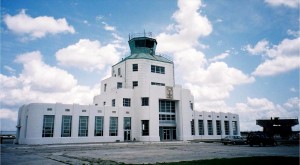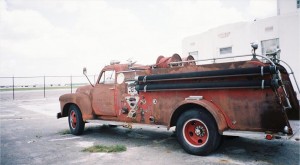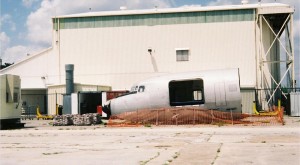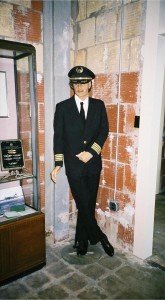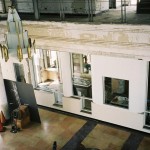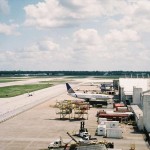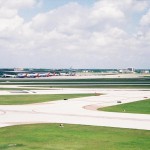By James G. Stanley
Houston’s old municipal airport terminal at William P. Hobby Airport is a classic example of airport architecture from what is often called the golden age of flight.
As airline service grew across the country, the city of Houston purchased W.T. Carter Airport, located southeast of downtown, and renamed it Houston Municipal Airport in June 1937. Eastern Airlines and Braniff Airlines provided scheduled service to Houston. With private and business flying expanding rapidly, the city began construction of a combination terminal/communications center/control tower in a new administration building designed by noted architect Joseph Finger.
The city formally dedicated the beautiful art deco terminal and a new hangar on Sept. 28, 1940. It served as the primary commercial air terminal for the Houston area until the city opened a new terminal across the field on Nov. 4, 1954.
Unlike most major cities, Houston didn’t raze its old terminal to make way for larger and more modern structures. The Houston Aeronautical Heritage Society formed in 1998 to lease and create a museum in the old 1940 terminal and adjacent property. HAHS members are excited about the terminal’s restoration.
“We’re making great progress with the work on the old building,” said George A. “Drew” Coats, HAHS president, chairman of the board and museum volunteer. “We have material on order to build a new hangar near the northwest corner of the terminal.”
A group of aviation, architecture and history enthusiasts from all walks of life and from across the country organized HAHS “to research, promote and preserve the rich aeronautical heritage of Houston and Southeast Texas.” The nonprofit corporation is funded through public and private grants, corporate and personal contributions and proceeds from revenue-generating programs.
The initial project for HAHS is the renovation and reconstruction of the 1940 Air Terminal Museum. Early investigation during the first phase of the work revealed that the interior walls contained asbestos. Although it posed a major problem, workers have successfully stripped and disposed of this material.
The $1.5 million phase two capital campaign will complete the ground-floor restoration and begin work on the second through fifth floors. The first floor two-story atrium includes the original marble floor and several tiled counters. The old art deco chandelier hangs from the ceiling. Workers will restore airline ticket counters to their original operations positions.
“I spend every minute I can here,” said Coats. His enthusiasm is apparent as he talks excitedly about the old building and future plans.
As the project progresses in phases, HAHS outfits and operates the terminal as an interactive museum. The plan calls for an Aviation Heritage Gallery of Douglas DC-3 exhibits; Airline and Hall of Fame Galleries, featuring uniforms and memorabilia from Houston’s dozen-plus scheduled airlines and general aviation; a children’s Dream of Flight Gallery; a display of an old-time communications center; and an airport viewing area, overlooking Houston Hobby Airport. Although walls still need resurfacing, artwork, uniforms, hardware and memorabilia are on display in these areas.
The museum owns a small collection of aircraft, including a flying 1943 Lockheed Lodestar business liner, a 1946 twin-engine Beechcraft D-018S and the nose section of a Douglas DC-6B airliner, Empress of Toronto, rescued from destruction in Florida.
Several other aircraft owned by local pilots and companies will be on display at the museum when not in use. These include a 1944 Beechcraft Model 17 Staggerwing and a 1947 Beechcraft Model 35 butterfly-tailed Bonanza.
Francisco Gutierrez, museum administrator and the only paid employee, handles much of the day-to-day detail work of running a museum.
“We’re growing and planning,” says Gutierrez.
He’s especially busy with the “Wings and Wheels” events held the third Saturday of each month. These events often honor or celebrate special dates or organizations of the past. Two of the summer Saturday slogans are “A Salute to Trans Texas Airways” and “Beechcraft Bonanza’s 60th Birthday Party.” Admission on these special days includes a light lunch, tour of the museum and admittance to the ramp to visit fly-in aircraft.
Next year, the museum will raffle off a recently acquired 1947 Cessna 140. This airplane won the 2004 “Best Continuously Maintained Antique” award at Oshkosh. Raffle tickets will cost $50 each and will be limited to 2,500. The airplane will be on display at several events around the nation and will be on view at the museum every Wings and Wheels Saturday.
For more information about the 1940 Air Terminal Museum, call 713-454-1940 or visit [http://www.1940airterminal.org].
- Eastern Airlines flight attendants donned this uniform in 1940.
- The Houston Aeronautical Heritage Society has recreated the 1940 terminal’s third floor communications center.
- The view from the terminal’s 2nd floor shows the original chandelier hanging in the lobby.
- A view of Hobby Airport from the old terminal’s 5th floor control tower.
- These hangars are south of the 1940 terminal.












